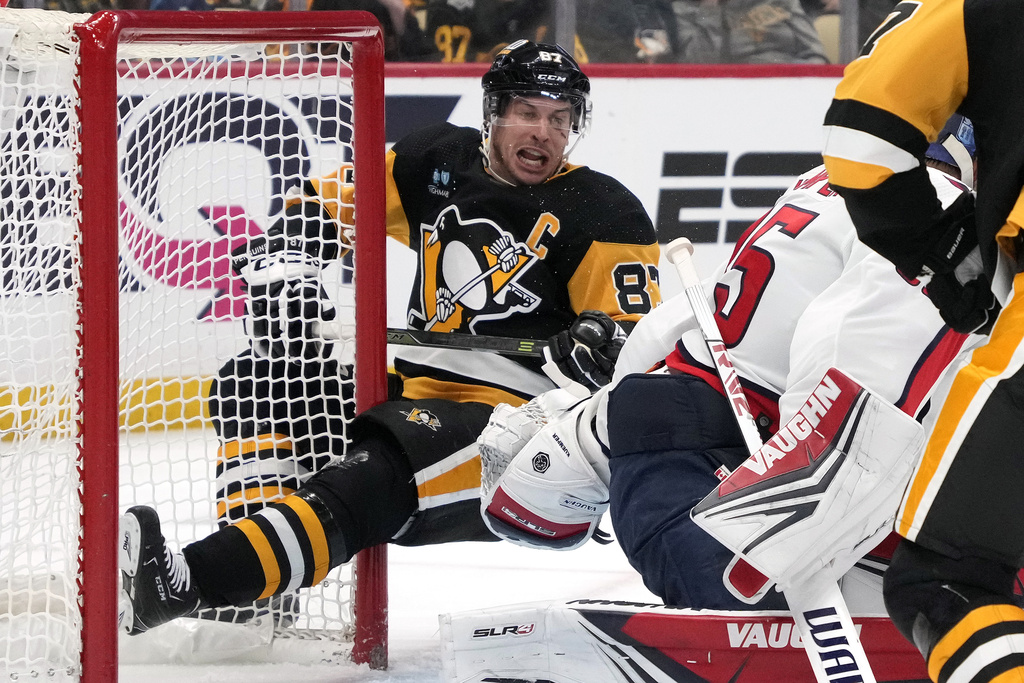Penguins
Comparing Penguins to Playoff-Bound Capitals; What Caps Did Better

Despite the air of optimism that came from building on the season’s stretch run which almost earned them a playoff berth, the Pittsburgh Penguins joined the bottom half of the league in watching the Stanley Cup Playoffs on television Saturday night.
The team the Penguins couldn’t catch was the Washington Capitals, who claimed their entry into the big dance with an empty net goal in Game 82 against the Philadelphia Flyers, whose eight-game losing streak with 11 games to go meant they had to win in regulation for a chance at the playoffs. So, Philadelphia pulled their goalie in a 1-1 game with three minutes to go.
The Flyers also underwent more than their share of adversity. Flyers GM Daniel Briere admitted their roster was “torn apart” as the start of a rebuild, and they dealt with learning teammate Carter Hart, who was one of the five players charged in the alleged sexual assault during the 2018 World Junior Championships.
The Flyers have already begun a rebuild. The Penguins have not. The Capitals … softly?
The Finish Line
The point total to qualify for the Eastern Conference playoffs was well below the standard 95-point target. Washington earned its berth with a surprising—OK, terrible—91 points, while the Penguins finished with 88.
Washington finished with a minus-37 goal differential, the worst goal differential for a playoff team in the salary cap era by a wide margin (the 2012 Florida Panthers were minus-24).
And they rode 30-year-old career backup goalie Charlie Lindgren, who played in 50 games, compared to presumptive starter Darcy Kuemper, who played in just 33 games this season.
The Penguins and Washington have been the oldest two teams in the league for the last couple of years running. Washington even lost top center Nick Backstrom in the first few weeks of the season, as he stepped away from hockey just one year after his triumphant return from hip surgery.
The 36-year-old Backstrom appears to be retired.
So, with a backup goalie and a terrible goal differential, how did the Washington Capitals make the playoffs, and the Pittsburgh Penguins did not?
Penguins, Capitals Differences
The answers will only fuel the many Penguins fans who want a new coach and more youth in the lineup because that’s exactly what Washington did.
Rookie head coach Spencer Carberry was highly sought out last summer and received interest from multiple teams before deciding to coach Alex Ovechkin and crew.
The Capitals’ top three centers are Connor McMichael, who is 23, Dylan Strome, who is 27, and Hendrix Lapierre, who is 22.
McMichael had only 33 points in 80 games and was a minus-20, but will pivot the old lions T.J. Oshie and Ovechkin when the Capitals begin the playoffs Sunday. McMichael was the 25th overall selection in the 2019 draft.
Lapierre was drafted 22nd overall in the 2020 draft. In his first substantial NHL action, he scored eight goals and registered 22 points in 50 games this season.
However, don’t invest too deeply in the narrative just yet.
The Capitals beat the teams they were supposed to beat. They were 3-0-0 against the Columbus Blue Jackets and 2-0-0 against lowly teams like the Anaheim Ducks, Calgary Flames, and Chicago Blackhawks.
They also fared well against the Philadelphia Flyers (2-0-1) and New Jersey Devils (3-1-0).
But here’s the tell-tale stat: Leads.
Washington blew only 12 leads all season. They lost nine one-goal leads (only five teams were better) and three two-goal leads. They did not lose a three or four-goal lead.
Ahem, Penguins.
The Penguins not only suffered losses to teams like Anaheim, Columbus, and Chicago, they gave up third period and multi-goal leads in doing so.
The Penguins changed the hockey axiom–the most dangerous lead in hockey is a 3-1 lead–into the most dangerous lead in hockey was any held by the Penguins.
According to MoreHockeyStats.com, the Penguins were the fifth-worst team with the lead in the NHL. They lost 15 one-goal leads, five two-goal leads, and one three-plus-goal lead. Only the Columbus Blue Jackets, San Jose Sharks, Montreal Canadiens, and Chicago Blackhawks were worse.
Four high lottery teams and the Penguins.
What would nine more wins mean for the Penguins? An easy playoff spot, possibly home-ice advantage in Round One.
That’s just another difference between the Penguins and Capitals.
In addition to the young centers, Washington dropped their average age to 28.6, according to Elite Prospects. The Penguins got their average age under 30 (29.9), but they were by no means a young team.
And the sloppy, absent-minded play dogged the Penguins again.
The Penguins’ repetitive, if not maddening, knack for giving up goals shortly after scoring ceded momentum and victories. Shorthanded goals were frequent icebergs for the Penguins’ ship; they were tied with the Arizona Coyotes for a league-worst 12 against.
Shorties change games. The one the Penguins allowed on Oct. 30 against the Anaheim Ducks with 13 seconds remaining directly cost them the game, and many others indirectly did so.
Ultimately, the Capitals did better than the Penguins, not just by getting younger but by appropriately holding leads and playing smarter hockey.
Had the Penguins done just a little better holding leads, played a little smarter, and not sulked around the NHL trade deadline, today’s Penguins’ stories would have been a Game 1 recap instead of the beginning of a months-long postmortem.












